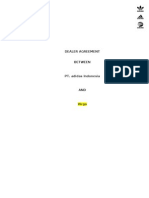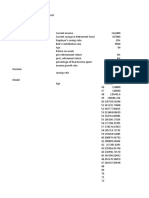Engineering Economics Quiz F1
Engineering Economics Quiz F1
Uploaded by
Marielle CochicoCopyright:
Available Formats
Engineering Economics Quiz F1
Engineering Economics Quiz F1
Uploaded by
Marielle CochicoCopyright
Available Formats
Share this document
Did you find this document useful?
Is this content inappropriate?
Copyright:
Available Formats
Engineering Economics Quiz F1
Engineering Economics Quiz F1
Uploaded by
Marielle CochicoCopyright:
Available Formats
Engineering Economics
Quiz F1
1. A machine shop purchased 10 years ago a milling machine for P60,000. A straight-line
depreciation reserve had been provided on a 20 year life of the machine. The owner of the
machine shop desires to replace the old milling machine with a modern unit of many
advantages costing P100,000. It can sell the old unit for P20,000. How much new capital will
be required for the purchase?
2. A tax and duty free importation of a 30 HP sand-mill (for paint manufacturing) cost
P360,000, CIF Manila. Bank charges, arrastre and brokerage cost P5,000. Foundation and
installation costs were P25,000. Other incidental expenses amounted to P20,000. Salvage
value of the mill is estimated to be P60,000 after 20 years. Find the appraisal value of the
mill, using straight-line depreciation, at the end of (a) 10 years and (b) 15 years.
3. On January 1, 1978, the purchasing engineer of a Cement Co. purchased a new machine
at a cost of P140,000. Depreciation has been computed by the straight-line method based
on an estimated useful life of five years and residual scrap value of P12,800. On January 2,
1981, extraordinary repairs (which were almost equivalent to a rebuilding of the machinery)
were performed at a cost of P30,400.
Because of the thorough going nature of these repairs, the normal life of the machinery was
extended materially. The revised estimate of useful life was four years from January 1, 1981.
Determine the annual provisions for depreciation for the years 1978 to 1980 and the
adjusted provision for depreciation on December
31, 1981. Assume payment in cash for the machine and extraordinary repairs.
4. Power to a remote transmitting station is provided by a Diesel-electric generator unit. The
original cost of the unit is P65,000.
It costs P2,000 to ship the unit to the job site. An additional cost of P3,000 was incurred for
installation.
(a) Determine, the annual depreciation cost by the straight line method, if the unit has an
expected life of 10 years. The salvage value of the unit at the end of its life was estimated at
P5,000.
(b) Determine the annual depreciation cost by the sinking fund method. Assume that the
annual charge for depreciation was deposited in a fund drawing compound interest at the
rate of 5%
5. An industrial plant bought a generator set for P90,000. Other expenses including
installation amounted to P10,000. The generator set is to have a life of 17 years with a
salvage value at the end of life of P5,000. Determine the depreciation charge during the
13th year and the book value at the end of 13 years by the (a) declining balance method, (b)
double declining balance method, (c) sinking fund method at 12% and (d) SYD method.
You might also like
- PpeDocument7 pagesPpeJasmine Marie Ng CheongNo ratings yet
- Financial Accounting TestbankDocument34 pagesFinancial Accounting Testbankemilio_ii71% (14)
- 16 - Property, Plant and EquipmentDocument2 pages16 - Property, Plant and EquipmentralphalonzoNo ratings yet
- Energy Storage: Legal and Regulatory Challenges and OpportunitiesFrom EverandEnergy Storage: Legal and Regulatory Challenges and OpportunitiesNo ratings yet
- Irregularities, Frauds and the Necessity of Technical Auditing in Construction IndustryFrom EverandIrregularities, Frauds and the Necessity of Technical Auditing in Construction IndustryNo ratings yet
- Engineering EcoDocument26 pagesEngineering EcoEric John Enriquez100% (2)
- Chapter 78Document7 pagesChapter 78Michaela Francess Abrasado AbalosNo ratings yet
- activity-present-economy-and-break-even-analysisDocument3 pagesactivity-present-economy-and-break-even-analysismisskaba123No ratings yet
- Activity 6890Document3 pagesActivity 6890Raymond Gicalde RementillaNo ratings yet
- Econ Ass No. 5Document6 pagesEcon Ass No. 5jilianneoctavianoNo ratings yet
- Individual Activity No. 1 Straight Line MethodDocument2 pagesIndividual Activity No. 1 Straight Line MethodIroha IsshikiNo ratings yet
- Engineering Eco PDF FreeDocument26 pagesEngineering Eco PDF FreeMJ ArboledaNo ratings yet
- Thermo Ee 40 Mse LawsDocument213 pagesThermo Ee 40 Mse Lawsplokplokplok0% (2)
- Year Book Value at The Beginning of The Year (P) Depreciation (P) Book Value at The End of The Year (P) 1 2 3 4 5Document9 pagesYear Book Value at The Beginning of The Year (P) Depreciation (P) Book Value at The End of The Year (P) 1 2 3 4 5Kevin SimonsNo ratings yet
- Week 7 Far PretestDocument16 pagesWeek 7 Far PretestCale HenituseNo ratings yet
- Geas 1Document84 pagesGeas 1Mariz-Elaine Noceja Rodriguez100% (7)
- At 1 January 2020Document6 pagesAt 1 January 2020Carl Yry Bitz100% (1)
- At 1 January 2020Document6 pagesAt 1 January 2020Carl Yry BitzNo ratings yet
- D4Document1 pageD4Rhandell CeninaNo ratings yet
- Board Work Problems DepreciationDocument2 pagesBoard Work Problems Depreciationkirstenryna23No ratings yet
- Auditing Problems Test Banks - PPE Part 1Document4 pagesAuditing Problems Test Banks - PPE Part 1Alliah Mae ArbastoNo ratings yet
- Audit of Property, Plant and EquipmentDocument13 pagesAudit of Property, Plant and EquipmentHijabwear BizNo ratings yet
- Breakeven SPDocument9 pagesBreakeven SPBernard BaluyotNo ratings yet
- PPE ExerciseDocument4 pagesPPE ExerciseLlyod Francis LaylayNo ratings yet
- Case Study ProjectDocument2 pagesCase Study ProjectRonald Renon QuiranteNo ratings yet
- Batscpar Far3Document9 pagesBatscpar Far3Krizza MaeNo ratings yet
- Activity I. Straight Line MethodDocument2 pagesActivity I. Straight Line MethodJhune UrabaNo ratings yet
- EconomicsDocument15 pagesEconomicsJM0% (2)
- Ppe 2Document7 pagesPpe 2Lara Lewis Achilles50% (2)
- Intacc FinalsDocument81 pagesIntacc FinalsargoNo ratings yet
- Eng Eco Set 2Document2 pagesEng Eco Set 2Krisia MartinezNo ratings yet
- Capital Revenue and ReceiptDocument2 pagesCapital Revenue and Receiptabhijeit86100% (1)
- IAS 16 Property Plant EquipmentDocument4 pagesIAS 16 Property Plant EquipmentMD Hafizul Islam HafizNo ratings yet
- Flores - Ge (Pahuling Part)Document30 pagesFlores - Ge (Pahuling Part)JhamellaNo ratings yet
- Assessment TasksDocument5 pagesAssessment TasksLDB Ashley Jeremiah Magsino - ABMNo ratings yet
- Capital Budgeting Exercises Part 1Document1 pageCapital Budgeting Exercises Part 1gadingancielomarieNo ratings yet
- Depreciation Problems With AnswersDocument1 pageDepreciation Problems With AnswersJHEZERIE NEPOMUCENONo ratings yet
- Eeco HWDocument19 pagesEeco HWMICHAELDANE SALANGUITNo ratings yet
- Depn CompDocument3 pagesDepn CompCassandra Dianne Ferolino MacadoNo ratings yet
- Comparison of AlternativesDocument2 pagesComparison of AlternativesBryan YuNo ratings yet
- Economy Problem Set 1Document4 pagesEconomy Problem Set 1jung biNo ratings yet
- BES 221 (PART I - Prefinal Module)Document9 pagesBES 221 (PART I - Prefinal Module)Kristy SalmingoNo ratings yet
- IAC PPE and Intangible Students FinalDocument4 pagesIAC PPE and Intangible Students FinalJoyce Cagayat100% (1)
- 1231231Document5 pages1231231joshua espirituNo ratings yet
- FT Problem Set 01 DepreciationDocument2 pagesFT Problem Set 01 DepreciationshaneNo ratings yet
- Cpa Review School of The Philippines ManilaDocument2 pagesCpa Review School of The Philippines ManilaRaquel Villar DayaoNo ratings yet
- Production and Maintenance Optimization Problems: Logistic Constraints and Leasing Warranty ServicesFrom EverandProduction and Maintenance Optimization Problems: Logistic Constraints and Leasing Warranty ServicesNo ratings yet
- Machines, Tools and Methods of Automobile ManufactureFrom EverandMachines, Tools and Methods of Automobile ManufactureRating: 4 out of 5 stars4/5 (1)
- Estimator's Piping Man-hours Tool: Estimating Man-hours for Carbon Steel Process Piping Projects. Manual of Man-hours, ExamplesFrom EverandEstimator's Piping Man-hours Tool: Estimating Man-hours for Carbon Steel Process Piping Projects. Manual of Man-hours, ExamplesNo ratings yet
- EU-China Energy Magazine Autumn Issue: 2020, #3From EverandEU-China Energy Magazine Autumn Issue: 2020, #3No ratings yet
- How Are Supercars Made? Technology Book for Kids 4th Grade | Children's How Things Work BooksFrom EverandHow Are Supercars Made? Technology Book for Kids 4th Grade | Children's How Things Work BooksNo ratings yet
- Global hydrogen trade to meet the 1.5°C climate goal: Part II – Technology review of hydrogen carriersFrom EverandGlobal hydrogen trade to meet the 1.5°C climate goal: Part II – Technology review of hydrogen carriersNo ratings yet
- EU China Energy Magazine 2024 June Issue: 2024, #2From EverandEU China Energy Magazine 2024 June Issue: 2024, #2No ratings yet
- EU China Energy Magazine 2022 Summer Double Issue: 2022, #6From EverandEU China Energy Magazine 2022 Summer Double Issue: 2022, #6No ratings yet
- Seminar in Management AccountingDocument6 pagesSeminar in Management AccountinglolaNo ratings yet
- Market Segmentation and Positioning ConceptsDocument15 pagesMarket Segmentation and Positioning ConceptsVineet GargNo ratings yet
- ABM104 Module5Document4 pagesABM104 Module5Keith BumaatNo ratings yet
- Corporate Valuation 9-9-12Document50 pagesCorporate Valuation 9-9-12pradeepbandiNo ratings yet
- Test Bank Advance AccountingDocument16 pagesTest Bank Advance AccountingJahry Kiwalan100% (1)
- DU Pont AnalysisDocument2 pagesDU Pont Analysisjennna89No ratings yet
- Secrets To SuccessDocument130 pagesSecrets To SuccessNguyễn Hoàng Nhật KhangNo ratings yet
- GROUP 3 - Suzuki Sun Motor Jakarta Final Paper (IO, OSCM, ABA)Document46 pagesGROUP 3 - Suzuki Sun Motor Jakarta Final Paper (IO, OSCM, ABA)FERDYANTO TJHAINo ratings yet
- Week 3 - ch14&16Document55 pagesWeek 3 - ch14&16bafsvideo4No ratings yet
- UntitledDocument3 pagesUntitledMamatha KerpudeNo ratings yet
- History: About Kotak Mahindra BankDocument15 pagesHistory: About Kotak Mahindra BankVishal PawarNo ratings yet
- Dealer Agreement GCDDocument49 pagesDealer Agreement GCDkiss_2108No ratings yet
- Problem Set 1 Answer SheetDocument3 pagesProblem Set 1 Answer SheetEnzo TimbolNo ratings yet
- Managerial Economics - Session 5 - MMUI - Rev 2022Document28 pagesManagerial Economics - Session 5 - MMUI - Rev 2022pusdiklatkm2No ratings yet
- Mallin4e ch04Document8 pagesMallin4e ch04Minh Thư Phạm HuỳnhNo ratings yet
- CH 9 The Analysis of Competitive MarketsDocument31 pagesCH 9 The Analysis of Competitive Marketsanon_670361819No ratings yet
- Treasury Cash ManagementDocument9 pagesTreasury Cash Managementvicenteferrer100% (1)
- Ch3 IAS40 Investment PropertyDocument31 pagesCh3 IAS40 Investment Propertyxu l100% (1)
- Local and International Business Environment of The FirmDocument2 pagesLocal and International Business Environment of The FirmMICHELLE MILANANo ratings yet
- Internship Report On Garments SectorDocument34 pagesInternship Report On Garments Sectorrayhan Kobir Pervez100% (1)
- Retirement PlanningDocument9 pagesRetirement PlanningPriyanka SharmaNo ratings yet
- Channel BehaviorDocument2 pagesChannel BehaviorLakkhanRobidas100% (1)
- BST MCQ MarketingDocument7 pagesBST MCQ Marketingsania sabharwalNo ratings yet
- 9 14 2015 Canaccord UADocument6 pages9 14 2015 Canaccord UAWilliam HarrisNo ratings yet
- Final Proj Sy2022-23 Agrigulay Corp.Document4 pagesFinal Proj Sy2022-23 Agrigulay Corp.Jan Elaine CalderonNo ratings yet
- A Study of Working Capital Management in Small Scale IndustriesDocument13 pagesA Study of Working Capital Management in Small Scale IndustriesIAEME PublicationNo ratings yet
- Assignment On SWOT Analysis, BCG Matrix, and Porter's Five Forces Model Analysis: A Case Study On Agora LTDDocument10 pagesAssignment On SWOT Analysis, BCG Matrix, and Porter's Five Forces Model Analysis: A Case Study On Agora LTDHaidar Jun ChowdhuryNo ratings yet
- Practice Exercises For Confras Units 5 and 6 - Part 1Document3 pagesPractice Exercises For Confras Units 5 and 6 - Part 1xylynn myka cabanatanNo ratings yet
- Revenue ManagementDocument27 pagesRevenue Managementvuduyduc100% (1)
- DigiNull IntroductionDocument1 pageDigiNull IntroductionNeel PatelNo ratings yet

























































































